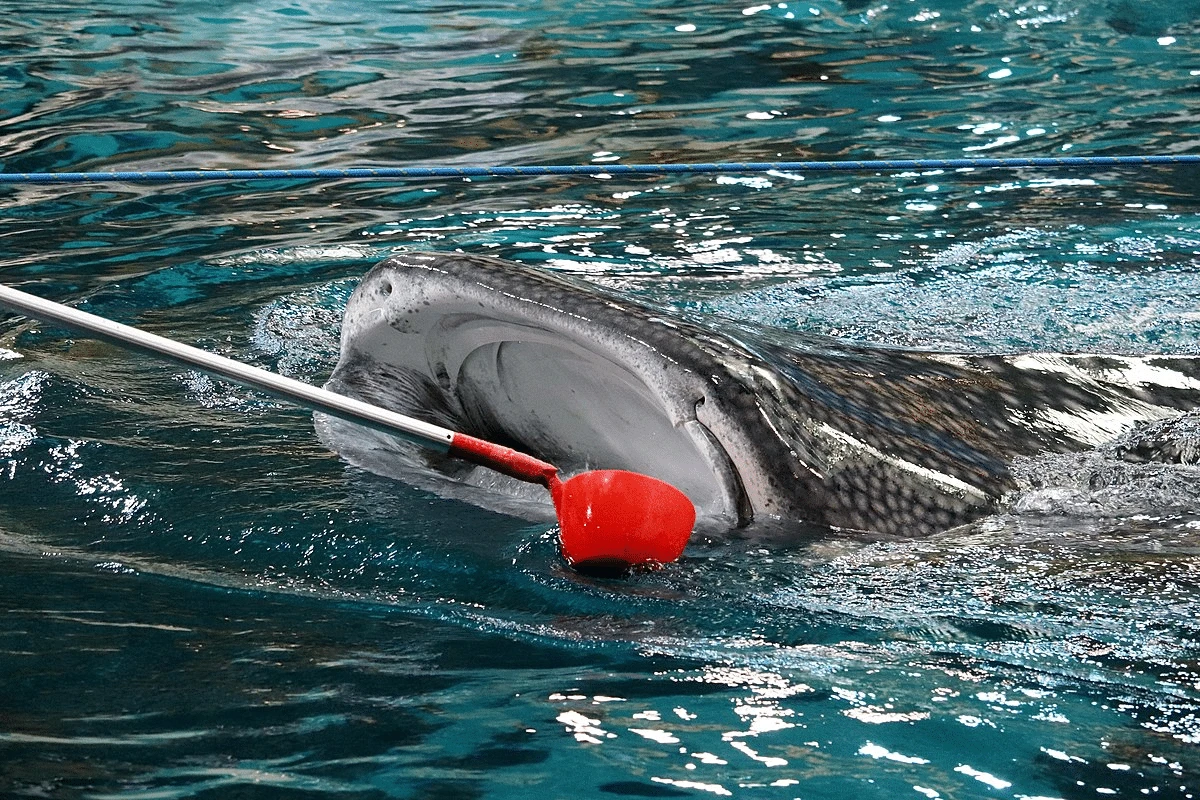Welcome to the Most Endangered Sharks.
Sharks are highly misunderstood animals. The most obvious example from popular culture is of course the iconic movie Jaws, which portrays these majestic marine animals as bloodthirsty man-eaters.
But in fact, many shark species are in a fragile position – risking extinction. In this article, we will look at the world’s top 22 most endangered sharks and see what we can do to protect them.
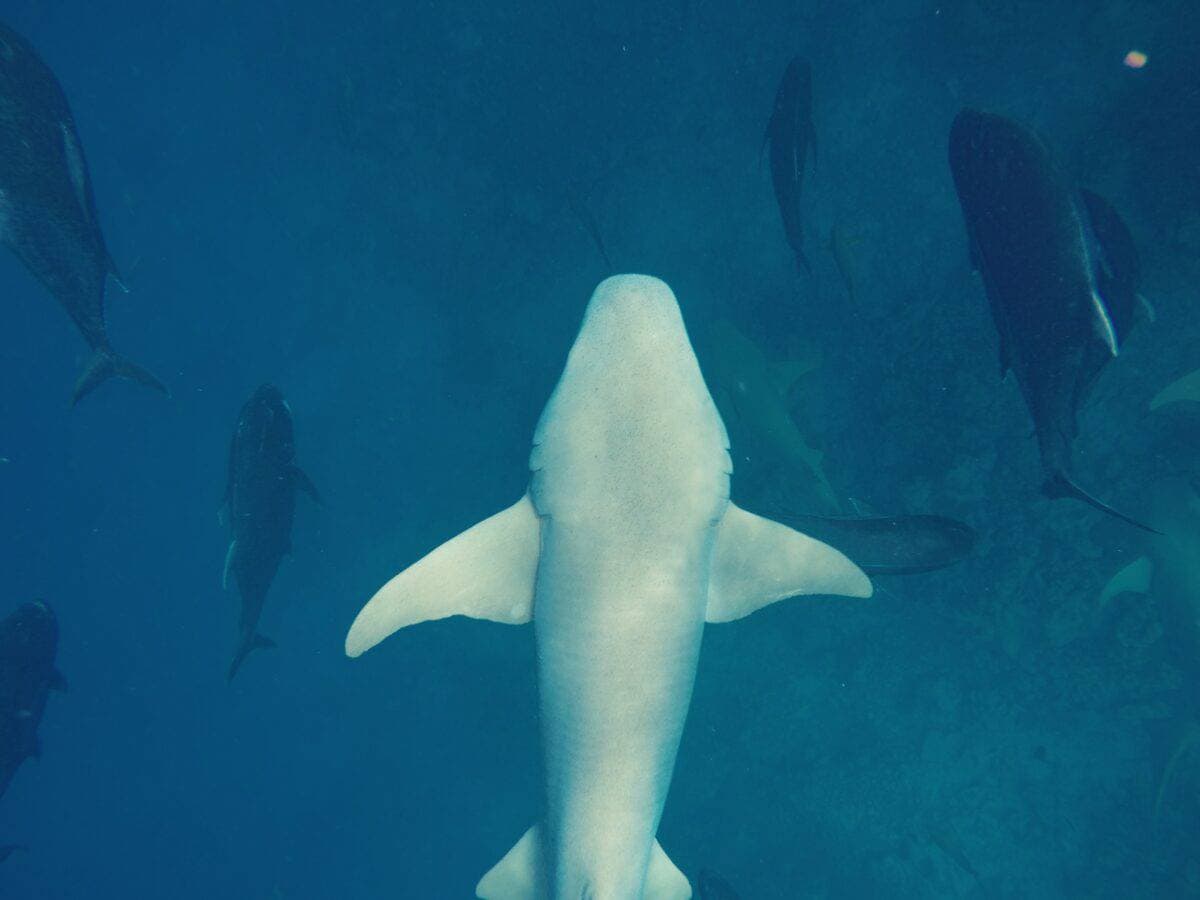
Swim ahead by following the links below.
Key points
| Species | Common Name | Avg. Length | Max Length | Conservation |
|---|---|---|---|---|
| Whale Shark | Whale Shark | 39-41 ft | Up to 60 ft | Endangered |
| Great White Shark | Great White Shark | 15-20 ft | Up to 20 ft | Endangered |
| Scalloped Hammerhead | Hammerhead Shark | 7-10 ft | Up to 14 ft | Endangered |
| Daggernose Shark | Daggernose Shark | 3-4 ft | Up to 4.9 ft | Critically Endangered |
| Ganges Shark | Ganges Shark | 6.6-9.8 ft | Up to 10 ft | Critically Endangered |
| Angel Shark | Angel Shark | 5-6.5 ft | Up to 8 ft | Endangered |
| Pondicherry Shark | Pondicherry Shark | 5-6 ft | Up to 8 ft | Critically Endangered |
| Basking Shark | Basking Shark | 20-26 ft | Up to 32 ft | Vulnerable |
| Porbeagle Shark | Porbeagle Shark | 6.6-10 ft | Up to 12 ft | Vulnerable |
| Smoothback Angel Shark | Angel Shark | 5-6.5 ft | Up to 8 ft | Endangered |
| Glyphis (Various) | Various Glyphis | Various | Various | Critically Endangered |
| Squatina squatina (Angel Shark) | Angel Shark | 5-6.5 ft | Up to 8 ft | Critically Endangered |
| Mustelus fasciatus (Striped Smooth-Hound) | Smooth-Hound Shark | 4-5 ft | Up to 6.5 ft | Least Concern |
| Glyphis sp. C (New Guinea River Shark) | River Shark | 6.5-8.2 ft | Not documented | Critically Endangered |
| Carcharias taurus (Sand Tiger Shark) | Sand Tiger Shark | 6-10.5 ft | Up to 11.5 ft | Vulnerable |
| Sphyrna mokarran (Great Hammerhead Shark) | Hammerhead Shark | 13-16 ft | Up to 20 ft | Endangered |
| Carcharhinus longimanus (Oceanic Whitetip Shark) | Whitetip Shark | 8-13 ft | Up to 14 ft | Vulnerable |
| Glyphis fowlerae (Borneo Shark) | Borneo Shark | Around 2.5 m | Up to 2.5 m | Data Deficient |
| Glyphis glyphis (Speartooth Shark) | Speartooth Shark | 7-8 ft | Up to 10 ft | Critically Endangered |
| Carcharhinus leiodon (Smoothtooth Blacktip Shark) | Blacktip Shark | Not documented | Not documented | Critically Endangered |
| Carcharhinus obscurus (Dusky Shark) | Dusky Shark | 9-11 ft | Up to 13 ft | Near Threatened |
| Glyphis siamensis (Irrawaddy River Shark) | River Shark | 6.6-7.9 ft | Up to 9.8 ft | Critically Endangered |
Introduction
Our sharks are essential to our oceans and the health of marine ecosystems. Yet, according to research we will lose around a hundred million sharks annually by the decade’s end.
Like many other species sharks are in danger of extinction due to habitat loss and pollution. Commercial fishing boats kill sharks by the millions every year. Clearly, sharks are being harvested at an unsustainable rate.
As coastal development continues, important shark habitats are being destroyed. It includes mangrove forests, seagrass beds, and coral reefs. Without these habitats, sharks cannot thrive. These threats have led to a sharp decline in shark populations worldwide.
The 23 most endangered sharks list includes many types of shark that you might not even have heard of!
#1 Whale Shark

| Category | Information |
|---|---|
| Species | Whale Shark (Rhincodon typus) |
| Size | Average Length: 39-41 feet (12-13 m) |
| Maximum Length: Up to 60 feet (18 m) | |
| Weight | Average Weight: 15-20 tons (30,000-40,000 lbs) |
| Maximum Weight: Over 40 tons (80,000 lbs) | |
| Coloration | Blue-grayish with white belly |
| Pale yellow spots and stripes on back and sides | |
| Mouth | Large mouth, approximately 4-5 feet wide (1.2-1.5 m) |
| Feeding Behavior | Filter feeder, consuming plankton, small fish, and other microscopic organisms |
| Lifespan | Estimated 70-100 years |
| Habitat | Warm, tropical and subtropical waters, but can be found in temperate regions |
| Often seen near the surface, but can dive to great depths | |
| Conservation Status | Endangered |
This is the largest shark species and you can read our dedicated article on the largest whale shark to get a true scope of their size!
However, despite its size, the majority of their diet consists of the small fish plankton. This makes them harmless towards humans. We are however as harmless towards this majestic animal and they are endangered due to overfishing and being caught as bycatch. Sadly, humans hunt them for their meat, oil, and fins. We can help the whale shark by not consuming their meat and products and by supporting organizations working to protect them.
#2 Great White Shark
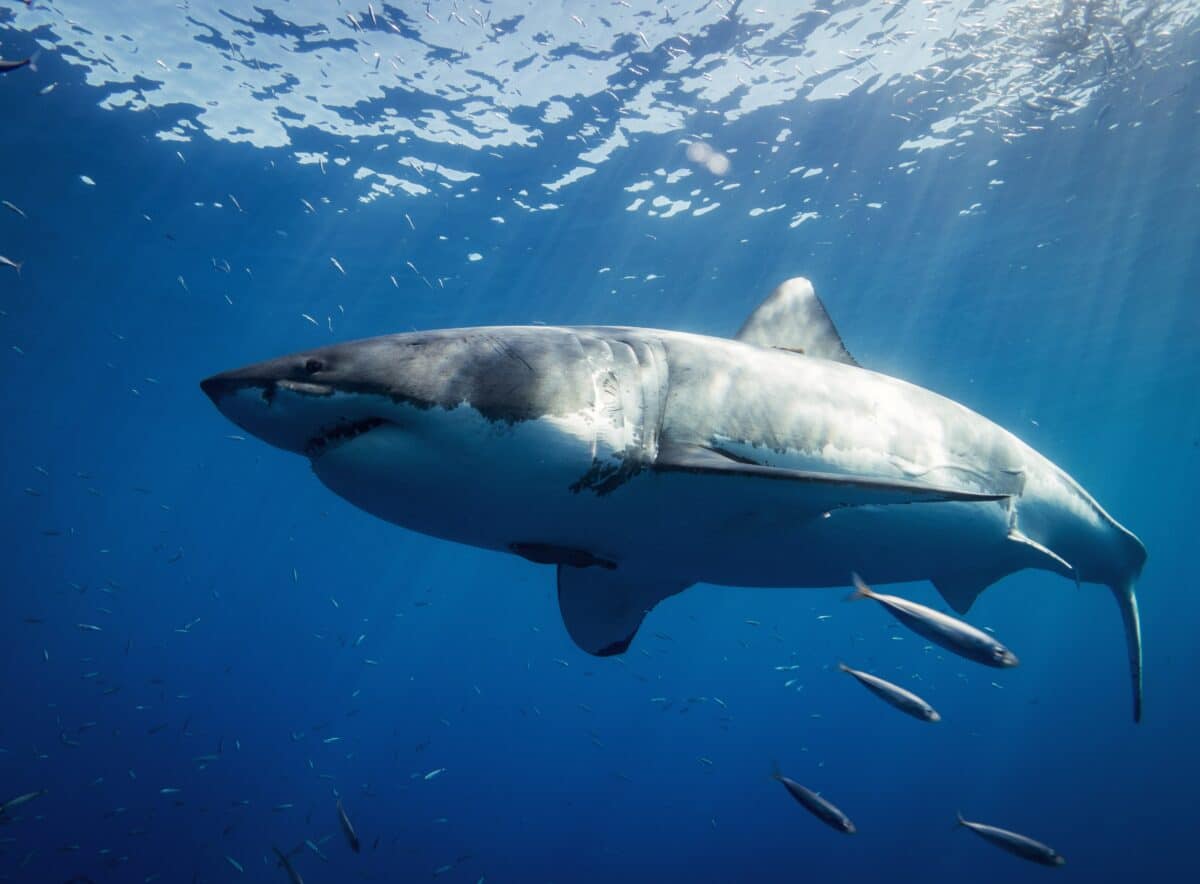
This is the most feared predator. But despite its fearsome reputation, this massive fish is in danger of extinction. Several reasons exist, including overfishing, habitat loss, and human exploitation.
Humans exploit Great White Sharks at an alarming rate. People use their jaw and teeth to make trophies and their fins to make soup. All around the world this exploitation contributes to the decline of great white shark populations.
We can help save great white sharks by working to reduce these threats through regulation of fisheries and banning the fin trade. We also need to educate people about the importance of these predators and the dangers they face.
Because no aquarium can hold a great white shark, they only have one home and must be protected.
With our help, great white sharks can recover and thrive in the oceans. If you are interested, you can read one of our dedicated articles on the topic!
#3 Scalloped Hammerhead

| Category | Information |
|---|---|
| Species | Scalloped Hammerhead shark (Sphyrna lewini) |
| Size | Average Length: 7-10 feet (2.1-3 meters) |
| Maximum Length: Up to 14 feet (4.3 meters) | |
| Weight | Average Weight: 200-300 pounds (90-136 kg) |
| Maximum Weight: Up to 450 pounds (204 kg) or more | |
| Coloration | Grayish-brown with a white or light-colored belly |
| Scalloped-shaped front margin of the hammer-shaped head | |
| Head | Unique hammer-shaped head, called a “cephalofoil” |
| Lifespan | Estimated 20-30 years |
| Habitat | Coastal and offshore waters worldwide |
| Often found in warm temperate and tropical seas | |
| Feeding Behavior | Carnivorous predator, feeding on fish, squid, octopus, |
| crustaceans, and occasionally small sharks and rays | |
| Social Behavior | Often found in schools, particularly when young |
| Conservation Status | Endangered |
The scalloped hammerhead is a large species of hammerhead shark and one of the world’s most endangered sharks. Overfishing poses a great threat to them as they are frequently caught as by-catch by fisheries. Shark fin soup is often made from the scalloped hammerhead’s fins, which are also harvested.
However, we can help the scalloped hammerhead in multiple ways. Firstly, we can support sustainable fisheries that do not target this species. We can also lobby for stricter regulations on shark finning and work to raise awareness of the plight of the scalloped hammerhead. Finally, we can support research and conservation efforts that are working to protect this species.
#4 Daggernose Shark

| Category | Information |
|---|---|
| Species | Daggernose Shark (Isogomphodon oxyrhynchus) |
| Size | Average Length: Approximately 3-4 feet (1-1.2 meters) |
| Maximum Length: Up to 4.9 feet (1.5 meters) | |
| Weight | Average Weight: Not well-documented |
| Coloration | Grayish-brown to bronze with a lighter underside |
| Head | Unique long, slender, and pointed snout, resembling a dagger |
| Lifespan | Estimated to be around 15-20 years |
| Habitat | Found in coastal waters and estuaries of the western Atlantic, particularly in Brazil and neighboring regions |
| Often inhabits shallow, nearshore environments | |
| Feeding Behavior | Likely feeds on small fish, crustaceans, and other invertebrates |
| Conservation Status | Critically Endangered |
This critically endangered species of requiem shark is endemic to the coast of South Africa. These sharks are threaten by bycatch, overfishing, and habitat loss, and degradation. Gillnets and trawl fisheries often catch the dagger nose shark as bycatch. Likewise, it is a main target of the South African shark finning industry.
It is vital to implement management measures of fisheries in order to reduce the amount of bycatch and incidental catch of this species. More research needs to be conducted into the ecology and life history of the Daggernose shark to understand better and protect this species. Finally, public awareness and education are key to helping protect this and other endangered species.
#5 Ganges Shark
| Category | Information |
|---|---|
| Species | Ganges Shark (Glyphis gangeticus) |
| Size | Average Length: Approximately 6.6 to 9.8 feet (2 to 3 meters) |
| Maximum Length: Up to 10 feet (3 meters) or more | |
| Weight | Average Weight: Not well-documented |
| Coloration | Grayish-brown with a lighter belly |
| Head | Short, broad snout |
| Lifespan | Estimated to be around 25-30 years |
| Habitat | Restricted to freshwater river systems in South Asia, including the Ganges, Brahmaputra, and Mahanadi River basins |
| Feeding Behavior | Carnivorous, likely preying on fish and other aquatic organisms |
| Conservation Status | Critically Endangered |
As its name suggests, th Ganges shark inhabits the Ganges River in India. It is one of four species of freshwater shark, and the only one known to inhabit the Ganges River. They are the top predator in the Ganges River ecosystem and therefore an important species in the river’s food web. Consequently its extinction would significantly impact the ecosystem. The Ganges shark is an apex predator, preying on various fish, including catfish, eels, and even other sharks.
It is under threat from a variety of human activities. The Ganges River is being dammed for hydroelectric projects, and its flow is being altered by irrigation and other water uses. Overfishing and pollution also pose a major threat. For these reasons they are on the IUCN’s list of the most endangered species. Thankfully Indian law protects these endangered sharks, though more needs to be done to save them.
#6 Angel Shark

| Category | Information |
|---|---|
| Species | Angel Shark (Squatina squatina) |
| Size | Average Length: Approximately 5 to 6.5 feet (1.5 to 2 meters) |
| Maximum Length: Up to 8 feet (2.4 meters) or more | |
| Weight | Average Weight: Approximately 77 to 132 pounds (35 to 60 kg) |
| Coloration | Usually brown or gray with lighter underside |
| Body Shape | Broad, flattened body with broad pectoral fins that resemble wings |
| Lifespan | Estimated to be around 25-35 years |
| Habitat | Found in the coastal and continental shelf waters of the Eastern Atlantic and the Mediterranean Sea |
| Often found on sandy or muddy bottoms | |
| Feeding Behavior | Carnivorous, feeding on a variety of bony fish, crustaceans, and cephalopods |
| Conservation Status | Endangered |
The Angel Shark is an endangered shark inhabiting the waters off the coast of California. Only around 200-300 of these sharks are thought to be left in the wild, and they are at risk of extinction due to numerous factors, including overfishing, bycatch, and habitat loss.
Several things can help the Angel Shark, including raising awareness of the species and its plight, reducing bycatch and habitat loss, and supporting research and conservation efforts.
Read more about the marine apocalypse on California’s coast with our dedicated article.
#7 Pondicherry Shark
| Category | Information |
|---|---|
| Species | Pondicherry Shark (Carcharhinus hemiodon) |
| Size | Average Length: Approximately 5-6 feet (1.5-1.8 meters) |
| Maximum Length: Up to 8 feet (2.4 meters) or more | |
| Weight | Average Weight: Not well-documented |
| Coloration | Grayish-brown with a lighter belly |
| Lifespan | Estimated to be around 25-30 years |
| Habitat | Previously found in the coastal waters of the Bay of Bengal |
| Often inhabited shallow, nearshore environments | |
| Feeding Behavior | Likely fed on small fish, crustaceans, and other invertebrates |
| Conservation Status | Critically Endangered |
This critically endangered species of requiem shark is endemic to the Bay of Bengal. It is one of the rarest and most endangered sharks worldwide, with an estimated population of only 250-270 individuals. The primary threats to this species are unsustainable fishing practices, including bycatch and finning.
To protect the Pondicherry shark and its habitat we can help by supporting conservation efforts to reduce fishing pressure and bycatch, and by advocating for stronger protections for this species. Being mindful of our seafood consumption and avoiding products that may contribute to the decline of this species is also a good way of preventing its extinction.
#8 Basking Shark

| Category | Information |
|---|---|
| Species | Basking Shark (Cetorhinus maximus) |
| Size | Average Length: Approximately 20-26 feet (6-8 meters) |
| Maximum Length: Up to 32 feet (10 meters) or more | |
| Weight | Average Weight: Around 5-7 tons (10,000-14,000 pounds) |
| Maximum Weight: Up to 8 tons (16,000 pounds) or more | |
| Coloration | Grayish-brown to blackish with a lighter underside |
| Mouth | Large mouth, approximately 3.3 feet (1 meter) wide |
| Feeding Behavior | Passive filter-feeder, mainly consuming plankton, small fish, and other microscopic organisms by filtering water through its gill rakers |
| Lifespan | Estimated to be around 50 years or more |
| Habitat | Found in temperate and cold waters worldwide |
| Often observed near the surface, but can dive to significant depths | |
| Conservation Status | Vulnerable |
The Basking shark is an enormous, slow-moving filter feeder that cruises the world’s oceans, preying on plankton. They are currently an endangered species. Several reasons for this decline include overfishing, bycatch, and habitat loss.
Overfishing is a major problem for the Basking shark. Their precious fins and oil cause them to be a target. Bycatch is also a major problem, as the Basking shark is often caught in nets meant for other fish. Lastly, habitat loss is also a threat to these creatures.
As the world’s oceans become more polluted and climate change causes sea levels to rise, the Basking shark’s habitat is increasingly threatened. We can help the Basking shark by supporting conservation efforts, such as those that seek to reduce bycatch and habitat loss.
#9 Porbeagle Shark

| Category | Information |
|---|---|
| Species | Porbeagle Shark (Lamna nasus) |
| Size | Average Length: Approximately 6.6 to 10 feet (2 to 3 meters) |
| Maximum Length: Up to 12 feet (3.7 meters) or more | |
| Weight | Average Weight: Approximately 440 to 660 pounds (200 to 300 kg) |
| Maximum Weight: Up to 1000 pounds (450 kg) or more | |
| Coloration | Grayish to bluish-gray on the upper body with a white belly |
| Teeth | Sharp and serrated, adapted for catching and holding prey |
| Lifespan | Estimated to be around 30-40 years or more |
| Habitat | Found in cold and temperate waters of the Atlantic, Pacific, and Indian Oceans |
| Prefers deep waters but can be found in coastal regions | |
| Feeding Behavior | Carnivorous, preying on a variety of fish and cephalopods |
| Reproduction | Viviparous, giving birth to live young after internal fertilization |
| Conservation Status | Vulnerable |
The Porbeagle shark is a large, fast-swimming shark found in temperate and cold waters worldwide. These sharks are prized for their meat, fins, and oil, so they are heavily hunted. Ever since the 1970s its population has been decreasing.
We can support conservation efforts that are working to reduce the demand for shark products. We must make people aware of these sharks’ dire situation and the significance of protecting these creatures.
#10 Smoothback Angel Shark
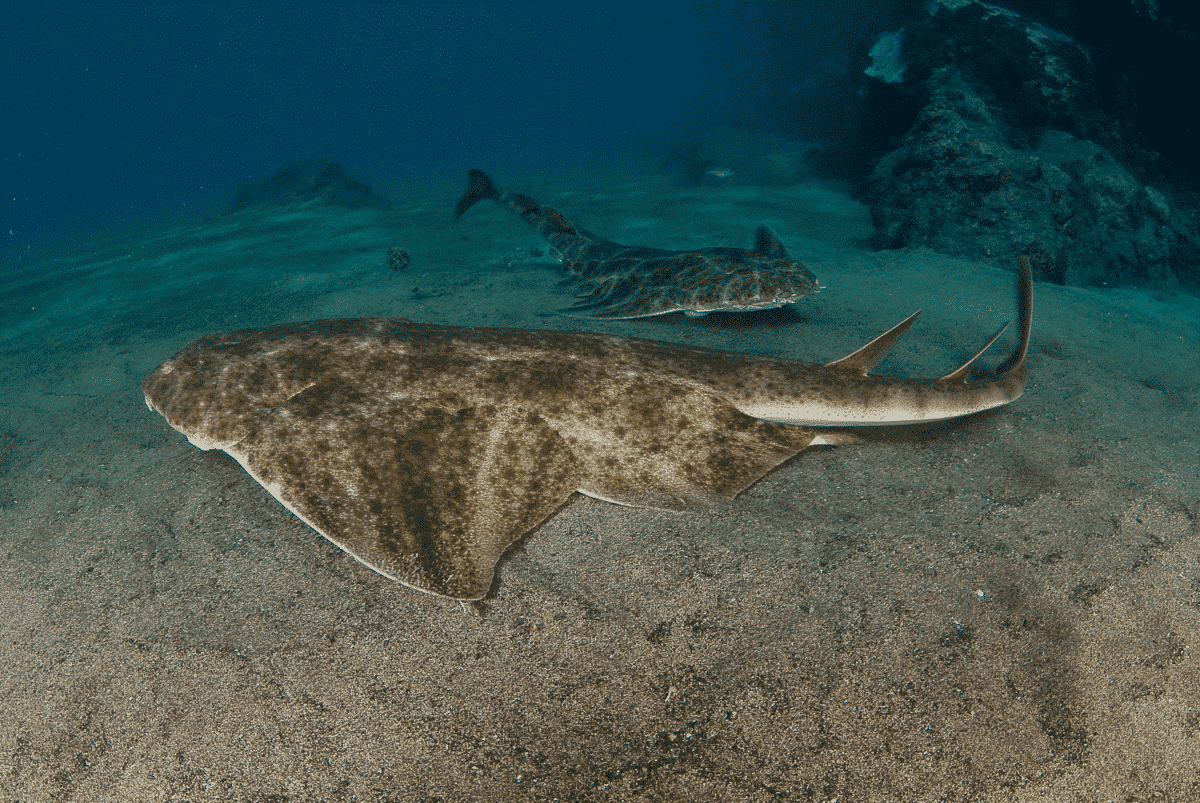
| Category | Information |
|---|---|
| Family | Squatinidae |
| Habitat | Sandy or muddy habitats in shallow waters, coastal areas, continental shelves, and estuaries |
| Physical Characteristics | Flattened body shape with broad pectoral fins resembling wings |
| Short snout with barbels on lower jaws | |
| Feeding Behavior | Opportunistic predators, feeding on small bony fish, crustaceans, and other bottom-dwelling invertebrates |
| Reproduction | Ovoviviparous – giving birth to live young after eggs hatch internally |
| Conservation Status | Some species are endangered or vulnerable due to overfishing, habitat degradation, and bycatch |
This creature is a requiem shark native to the coasts of Africa and Arabia. Compared to other sharks it is a very tiny species with a maximum length of 1.6 m. The Smoothback angel shark is a bottom-dwelling shark that prefers sandy or muddy habitats in shallow waters. They are nocturnal predators which feed on small bony fish, squid, and crustaceans.
The Smoothback Angel is part of the IUCN Red List. The primary threat to this species is fisheries bycatch. The Smoothback Angel Shark is often caught as a bycatch in bottom trawls and gillnets. It is also harvested for its meat, fins, and liver oil. Conservation efforts for this species include activism to improve regulations on bottom trawling, especially in areas where the Smoothback Angel Shark is common.
#11 Squatina Squatina

| Category | Information |
|---|---|
| Species | Squatina squatina |
| Common Name | Angel Shark |
| Size | Average Length: Approximately 5 to 6.5 feet (1.5 to 2 meters) |
| Maximum Length: Up to 8 feet (2.4 meters) or more | |
| Weight | Average Weight: Approximately 440 to 660 pounds (200 to 300 kg) |
| Maximum Weight: Up to 1000 pounds (450 kg) or more | |
| Coloration | Grayish-brown to blackish with a lighter underside |
| Physical Characteristics | Broad, flattened body with broad pectoral fins that resemble wings |
| Habitat | Found in various regions of the Eastern Atlantic Ocean and the Mediterranean Sea |
| Inhabits sandy or muddy bottoms, as well as seagrass and rocky areas | |
| Feeding Behavior | Carnivorous, preying on a variety of fish and cephalopods |
| Conservation Status | Critically Endangered |
The Squatina squatina is found in the Mediterranean Sea and the Atlantic Ocean. Due to its slow reproductive rate it is particularly prone to overfishing. Such overfishing not only reduces the number of Squatina Squatina in the wild, but also disrupts the species’ food chain. In turn, this may lead to the depletion of other species that the Squatina Squatina relies on for food.
Additionally, habitat loss and pollution also contributes to the decline of the Squatina Squatina. It can happen due to human activity, such as fishing, mining, or construction. Pollution harms the Squatina Squatina while also contaminating the water and making it difficult for the shark to find food.
We can assist the Squatina Squatina by supporting sustainable fishing practices. It means fishing in a way that does not damage the environment and not overfishing. Another way to help is to reduce pollution by properly disposing of waste and by using less harmful chemicals. Creating marine protected areas or replanting coral reefs is also essential, and would help many other endangered species.
#12 Glyphis
| Species | Common Name | Habitat | Conservation Status |
|---|---|---|---|
| Glyphis gangeticus | Ganges Shark | Ganges and Brahmaputra River systems in South Asia (India, Bangladesh) | Critically Endangered |
| Glyphis siamensis | Irrawaddy River Shark | Irrawaddy River in Southeast Asia (Myanmar, Thailand) | Critically Endangered |
| Glyphis garricki | Northern River Shark | River systems in northern Australia | Critically Endangered |
| Glyphis glyphis | Speartooth Shark | Northern Australia and southern New Guinea | Critically Endangered |
The Glyphis is a type of river dolphin living in estuarine and freshwater rivers in northern Australia and southern New Guinea. Entanglement in fishing gear, pollution, and habitat loss are the main reasons causing their endangerment.
Various conservation efforts could help the Glyphis, such as: reducing pollution and increasing the awareness of the importance of these dolphins. Additionally, it is important to support efforts to protect their habitat, including working to reduce habitat loss and fragmentation.
#13 Striped Smooth-Hound
| Category | Information |
|---|---|
| Species | Striped Smooth-Hound (Mustelus fasciatus) |
| Common Name | Striped Smooth-Hound |
| Size | Average Length: Approximately 4 to 5 feet (1.2 to 1.5 meters) |
| Maximum Length: Up to 6.5 feet (2 meters) or more | |
| Weight | Average Weight: Approximately 20 to 40 pounds (9 to 18 kg) |
| Maximum Weight: Up to 50 pounds (22 kg) or more | |
| Coloration | Grey or brown with distinct dark stripes along its body, especially on its back and sides |
| Habitat | Found in shallow coastal waters of the Western Atlantic Ocean, from Massachusetts (USA) to Argentina |
| Often inhabits sandy or muddy bottoms | |
| Feeding Behavior | Carnivorous, feeding on small fish, crustaceans, and other bottom-dwelling invertebrates |
| Reproduction | Ovoviviparous – giving birth to live young after eggs hatch internally |
| Conservation Status | Least Concern |
The Striped Smooth-Hound is a species of houndshark found in the western Atlantic Ocean. The Striped Smooth-Hound is often caught as a bycatch in gillnets and trawls. Moreover, this species is also popular in the live fish trade.
To support this creature we must adopt sustainable fishing practices. It means buying fish caught using methods that don’t harm other marine life, avoiding products made from sharks. Finally, we can help by raising awareness about this endangered species. We can do this by sharing information about the Striped Smooth-Hound with others and by supporting conservation efforts.
#14 New Guinea River Shark
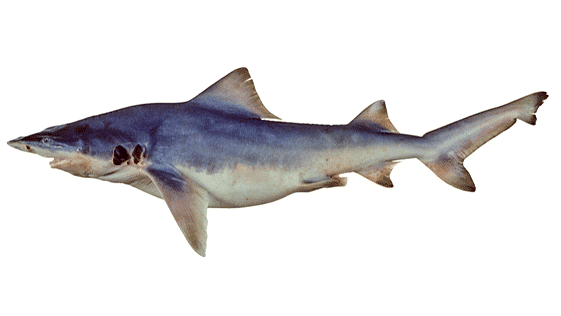
| Category | Information |
|---|---|
| Species | Glyphis sp. C (New Guinea River Shark) |
| Common Name | New Guinea River Shark |
| Size | Estimated to be around 6.5 to 8.2 feet (2 to 2.5 meters) |
| Weight | Not well-documented |
| Habitat | Found in the freshwater river systems of New Guinea (Papua New Guinea and Papua Province of Indonesia) |
| Feeding Behavior | Carnivorous, likely preying on fish and other small aquatic organisms |
| Conservation Status | Critically endagered |
The New Guinea River Shark is a species of requiem shark that is endemic to the waters of New Guinea. This species faces several threats, including habitat loss, overfishing, and pollution.
We can help the New Guinea river shark by protecting its habitat and working to reduce the threats it faces. This includes reducing habitat loss and degradation, protecting it from overfishing, and reducing the environmental pollution.
#15 Sand Tiger Shark

| Category | Information |
|---|---|
| Species | Sand tiger shark (Carcharias taurus) |
| Other Names | Grey Nurse shark, Spotted Ragged-Tooth shark |
| Size | Average Length: 6 to 10.5 feet (1.8 to 3.2 meters) |
| Maximum Length: Up to 11.5 feet (3.5 meters) or more | |
| Weight | Average Weight: Around 200 to 350 pounds (90 to 159 kg) |
| Coloration | Brownish-gray or bronze with distinctive dark spots and ragged, protruding teeth |
| Habitat | Found in coastal and offshore waters of temperate and subtropical regions worldwide |
| Often seen near rocky reefs, shipwrecks, and underwater structures | |
| Feeding Behavior | Predatory, primarily feeding on fish and cephalopods |
| Behavior | Relatively docile but may look intimidating due to its large teeth; it is not known to be a threat to humans |
| Conservation Status | Vulnerable |
These sharks exist in a large portion of the western Atlantic Ocean, stretching from New Jersey to Florida in the United States, and from northern Brazil to southern Argentina. The sand tiger is a large shark, with males reaching a length of up to 3.2 m (10 ft) and females reaching a length of up to 4 m (13 ft). Yes that’s correct – unusually the female is bigger than the males. They are a relatively slow-moving shark and often stays near the bottom of the ocean.
Moreover it is a viviparous species, which means that the females give birth to live offspring. Overfishing and habitat loss put the sand tiger shark at risk. This creature is hunted for its fins, used in the shark fin soup trade, and is frequently caught as a bycatch in fisheries. There are several ways we can help the sand tiger shark, such as by supporting conservation efforts and avoiding purchasing products made from shark’s fins.
#16 Great Hammerhead Shark

| Category | Information |
|---|---|
| Species | Great Hammerhead Shark (Sphyrna mokarran) |
| Size | Average Length: 13 to 16 feet (4 to 5 meters) |
| Maximum Length: Up to 20 feet (6 meters) or more | |
| Weight | Average Weight: Approximately 500 to 1,000 pounds (227 to 454 kg) |
| Maximum Weight: Up to 1,300 pounds (590 kg) or more | |
| Coloration | Grayish-brown to olive-green with a white belly |
| Head | Distinctive hammer-shaped head (cephalofoil) |
| Habitat | Found in coastal and offshore waters worldwide |
| Often found near the coast and in deep waters | |
| Feeding Behavior | Carnivorous, preying on a variety of fish, squid, octopus, and other marine animals |
| Social Behavior | Generally solitary, but aggregations can occur at specific locations and during mating seasons |
| Conservation Status | Endangered |
The great hammerhead sharks main threats to this species are overfishing and bycatch. Additionally, coastal development and pollution is currently degrading its habitat.
We can help the great hammerhead shark by cleaning up coastal areas and reducing pollution. Finally, we can raise awareness about the great hammerhead shark and the threats it faces.
#17 Oceanic Whitetip Shark
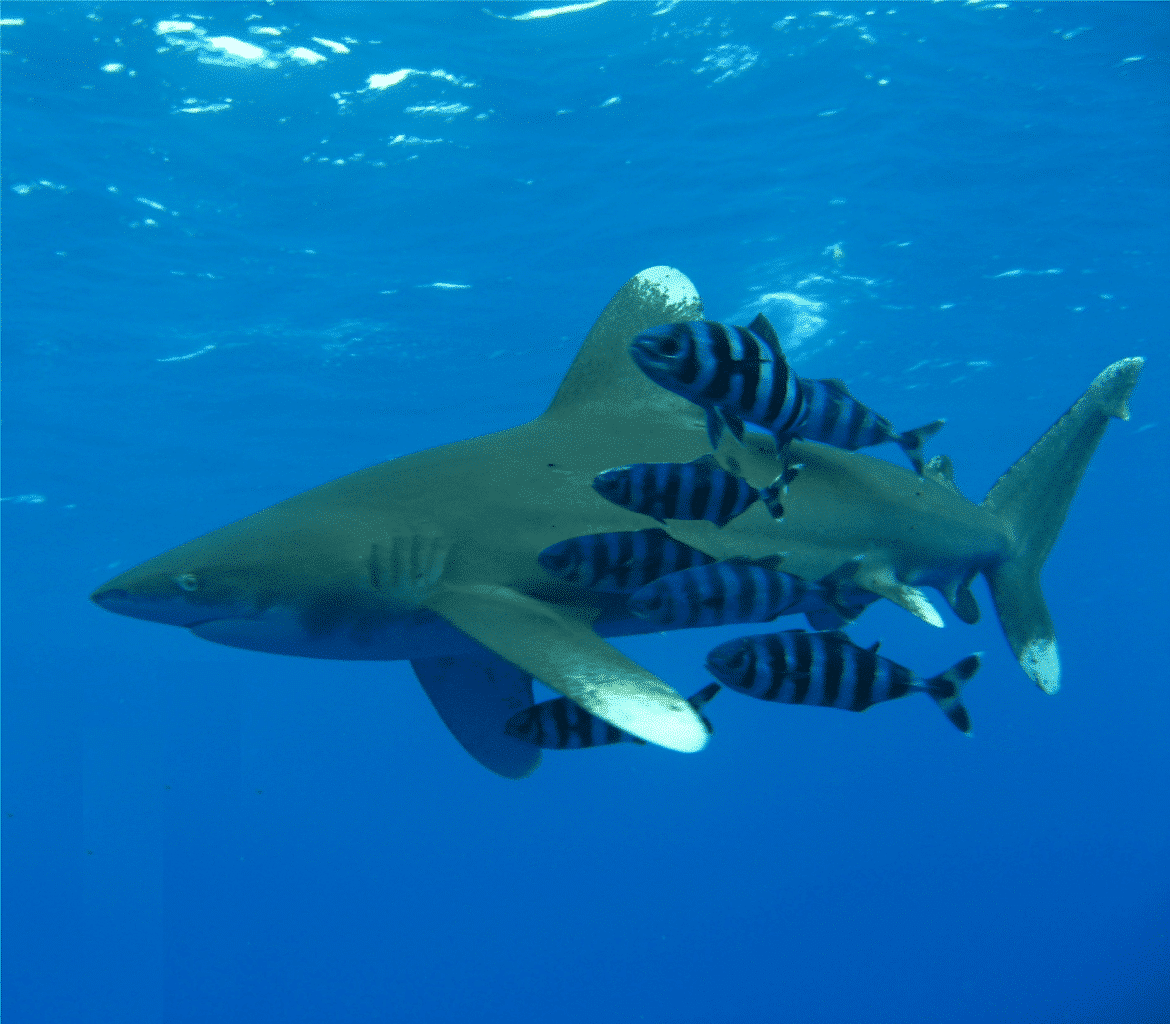
| Category | Information |
|---|---|
| Species | Oceanic Whitetip Shark (Carcharhinus longimanus) |
| Size | Average Length: Approximately 8 to 13 feet (2.5 to 4 meters) |
| Maximum Length: Up to 13 to 14 feet (4 to 4.3 meters) | |
| Weight | Average Weight: Around 350 to 660 pounds (159 to 300 kg) |
| Coloration | Bluish-gray to bronze on the upper body with a white belly and distinctive white-tipped fins |
| Habitat | Found in warm oceanic waters around the world |
| Pelagic species, often far from shore and in open ocean environments | |
| Feeding Behavior | Opportunistic and primarily scavenger in nature |
| Feeds on a variety of prey, including small fish, squid, crustaceans, and carrion | |
| Social Behavior | Solitary and occasionally forms loose aggregations |
| Conservation Status | Vulnerable |
It is yet a beautiful and majestic creature of the ocean which is risking extinction. According to estimations, only 300-500 of these sharks still live in the wild. Again, it is overfishing which is causing their endangerment. Their fins are highly prized in the Asian market as they are used in shark fin soup. Consequently, these sharks are frequently captured and their fins removed while they are still alive.
It is an extremely cruel practice that must come to an end. There are many ways that we can help these sharks. One way is to support organizations that are working to stop the practice of finning. Another way is to boycott restaurants that serve shark fin soup. We can raise awareness about this issue and educate others on the importance of saving these amazing creatures.
#18 Borneo Shark
The Borneo shark is found in the waters around the island of Borneo. This shark is on the IUCN Red List due suffering from overfishing and habitat loss. Growing to a maximum length of around 2.5 meters it is a relatively small shark. The Borneo Shark is a top predator in its environment, feeding on fish, squid, and octopuses.
They are in danger due to overfishing and habitat loss. There is currently no conservation action for this species, which is decreasing in number quickly.
In order to help the Borneo shark; firstly, fisheries need to operate in a way that reduces the bycatch of this species. Secondly, coastal development needs to be done in such a way as to minimize habitat loss. Finally, raising public awareness of the plight of the Borneo shark to generate support is also important.
#19 Speartooth Shark

| Category | Information |
|---|---|
| Species | Speartooth Shark (Glyphis glyphis) |
| Other Names | None |
| Size | Average Length: Approximately 7 to 8 feet (2 to 2.5 meters) |
| Maximum Length: Up to 10 feet (3 meters) or more | |
| Weight | Average Weight: Not well-documented |
| Coloration | Grayish-brown to bronze on the upper body with a lighter belly |
| Habitat | Found in the rivers and estuaries of northern Australia and southern New Guinea |
| Prefers freshwater habitats | |
| Feeding Behavior | Carnivorous, preying on fish and other aquatic organisms |
| Conservation Status | Critically Endangered |
The Speartooth Shark is a critically endangered species of requiem shark, and one of the world’s largest sharks found in the Indo-Pacific region and can grow up to 12 feet long. These species are apex predators and are essential to the health of the marine ecosystem. However, they are endangered due to overfishing and being coveted for their fins – as so many other shark species.
Only an estimated 300-500 Speartooth Sharks still exist in the wild, a number which is declining even further. We can protect them by supporting conservation efforts and refusing to purchase products made from their fins. Likewise, we can also spread awareness about this amazing species and the dangers they face to build support for their protection.
#20 Smoothtooth Blacktip Shark
The Smoothtooth Blacktip Shark is in danger of extinction due to overfishing and losing its natural habitat. They make a dangerous predator in the Indian and Pacific Oceans coral reefs, where it preys on fish, octopuses, and squid.
The loss of this species would have a devastating effect on the delicate balance of the coral reef ecosystem. We can do several things to help the Smoothtooth Blacktip Shark, including reducing our consumption of seafood, supporting sustainable fisheries, and protecting coral reefs.
#21 Dusky Shark
| Category | Information |
|---|---|
| Species | Dusky Shark (Carcharhinus obscurus) |
| Size | Average Length: Approximately 9 to 11 feet (2.7 to 3.4 meters) |
| Maximum Length: Up to 13 feet (4 meters) or more | |
| Weight | Average Weight: Around 400 to 790 pounds (181 to 358 kg) |
| Maximum Weight: Up to 1,100 pounds (500 kg) or more | |
| Coloration | Brown to grayish-brown with a white or light-colored underside |
| Habitat | Found in tropical and temperate waters worldwide |
| Often seen near the coast, but can be found offshore as well | |
| Feeding Behavior | Predatory, feeding on a variety of fish and cephalopods |
| Social Behavior | Generally solitary and not known for forming large groups |
| Conservation Status | Near Threatened |
The Dusky shark (Carcharhinus obscurus) is a large coastal shark in temperate and tropical waters worldwide. Due to their aggressive nature, they are one of the most dangerous sharks to humans. Recreational and commercial fisheries often target these sharks. Therefore, the Dusky Shark is also one of the most endangered sharks in the world.
There are many reasons why the Dusky Shark is in danger of extinction. One of the main reasons is overfishing, and is also a popular target for shark finning. In addition, the Dusky Shark’s slow reproductive rate means that it cannot keep up with the high mortality levels.
To reduce the demand for shark products one can raise awareness of the plight of sharks, and the importance of conserving them.
#22 Irrawaddy River Shark
| Category | Information |
|---|---|
| Species | Irrawaddy River Shark (Glyphis siamensis) |
| Other Names | None |
| Size | Average Length: Approximately 6.6 to 7.9 feet (2 to 2.4 meters) |
| Maximum Length: Up to 9.8 feet (3 meters) or more | |
| Weight | Average Weight: Not well-documented |
| Coloration | Grayish-brown to bronze on the upper body with a lighter belly |
| Habitat | Found in the Irrawaddy River and its estuaries in Myanmar and Thailand |
| Feeding Behavior | Carnivorous, preying on fish, crustaceans, and other small aquatic organisms |
| Conservation Status | critically Endagered |
The Irrawaddy River Shark is a critically endangered species of requiem shark. It inhabits the Irrawaddy River in Myanmar, making it one of the few riverine sharks worldwide. The primary threat to the Irrawaddy river shark is overfishing, often caught as bycatch in gillnet and trawl fisheries. Therefore, the IUCN has listed the Irrawaddy river shark as “critically endangered” and urges immediate conservation action to save the species from extinction.
We can support organizations working to protect the species, such as the Wildlife Conservation Society (WCS) Myanmar, and raise awareness.
Final Word
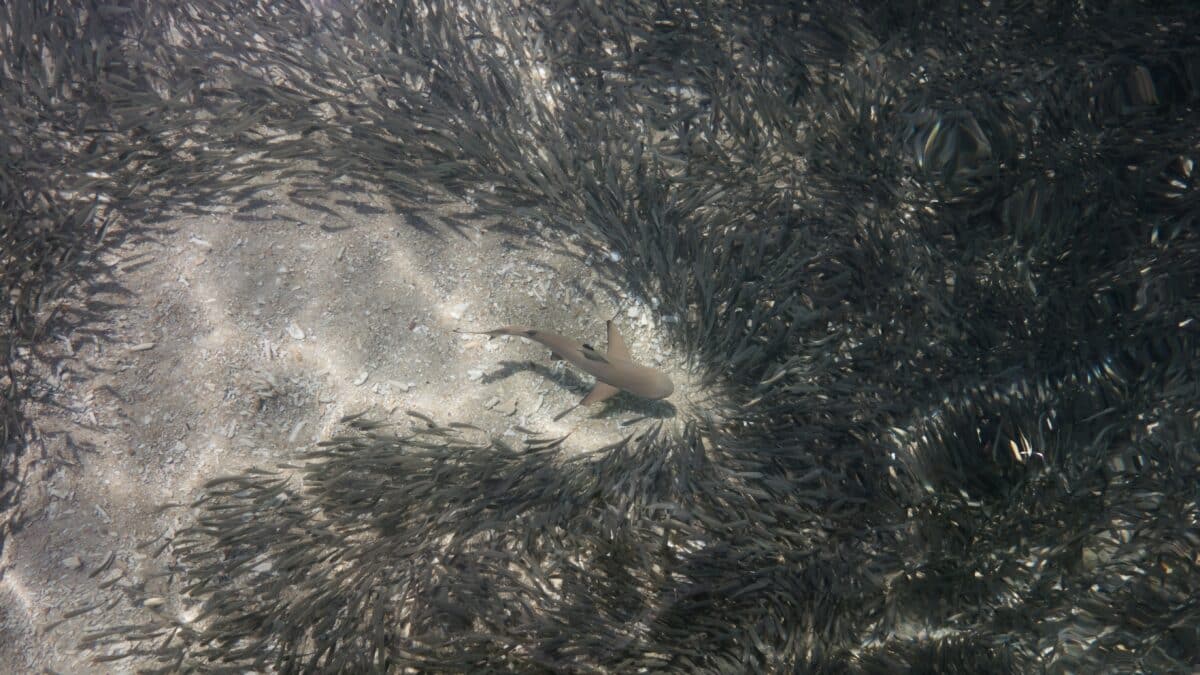
This article lists 22 most endangered sharks in the world. All of these sharks are at risk of extinction mainly due to overfishing, habitat loss, and finning. Despite being dangerous, they are actually desperate for our help.
It is crucial that these enormous creatures continue to thrive in the world’s oceans as they are extremely important for marine eco-systems.
Therefore us humans need to take responsibility. We must assist in building a future for sharks, oceans, and people. We’re finding new ways to protect the ocean. We’re creating new technologies that change the way the world does business. Additionally, we are doing everything in our power to improve the world.
The decrease in shark populations also affects the shark cage diving industry, you can read more about the relationship between sharks and the cage diving industry with another one of our articles.
Thank you for reading this article! If you are brave enough maybe you are dreaming about coming face to face with these fascinating ocean creatures? Then you should also read our article on The Best Places to Dive with Sharks.
Frequently Asked Questions (FAQs)
Sharks face various threats that contribute to their endangered status. Overfishing, where sharks are targeted for their fins, meat, or other products, is one of the most significant threats. Bycatch, the unintentional capture of sharks in fishing gear targeting other species, also affects their populations. Habitat destruction, pollution, and climate change further exacerbate the decline of shark populations
As of September 2021, more than 180 shark species are considered threatened or near-threatened on the International Union for Conservation of Nature (IUCN) Red List. This includes species classified as critically endangered, endangered, and vulnerable.
Sharks play a crucial role in maintaining the health and balance of marine ecosystems. As top predators, they help control the populations of prey species, which in turn influences the overall structure of the food web. Healthy shark populations are essential for the well-being of marine ecosystems and the species within them.
The extinction of sharks could have significant consequences for marine ecosystems. Without sharks to regulate prey populations, certain species may overpopulate and disrupt the ecological balance. This “trophic cascade” effect can lead to the decline of other species and impact the entire marine food web.
Why are sharks afraid of dolphins?
- Magpie Bird Is Reunited with Her Dog Best Friend - April 24, 2024
- Dog Saves Another Dog From Drowning in Fish Pond - April 23, 2024
- Man On Motorbike Rescues Cat From Highway - April 23, 2024

